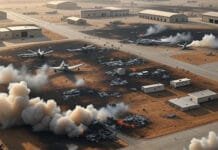Damascus, the capital of Syria, stands on the precipice of monumental change as tensions escalate and rebel forces close in on the historic city. The atmosphere is one of uncertainty, fear, and speculation as residents grapple with the unfolding chaos and an uncertain future. This development marks a critical juncture in Syria’s protracted conflict, as key players make moves that could redefine the nation’s trajectory.
Rebels Claim Symbolic Victory at Umayyad Mosque
In a historic turn of events, leaders of Syria’s rebel factions, notably the Islamist Hayat Tahrir al-Sham (HTS) group, declared a significant victory. From the iconic Umayyad Mosque, HTS leader Abu Mohammad al-Jolani, who now goes by his real name, Ahmad al-Shara, delivered a fiery address. In his speech, he proclaimed the fall of Damascus as not merely a victory for the rebels but a “triumph for the entire Islamic nation.”
Al-Shara emphasized the symbolic and strategic importance of this victory, heralding it as a decisive moment in Syria’s ongoing struggle for liberation. He further credited the success to the resilience of imprisoned fighters and the dedication of the mujahideen who “broke their chains” to join the fight.
The Flight of Bashar al-Assad: A Power Vacuum Emerges
Amid the chaos, President Bashar al-Assad has reportedly fled the country. This development underscores the severity of the situation and signals the collapse of his regime. Assad’s authoritarian rule, marked by allegations of widespread brutality and corruption, had long been sustained by allies like Russia and Iran.
His departure has sparked celebrations not only in Damascus but also across other parts of Syria and abroad. The fall of Assad’s regime, once perceived as unassailable, has injected a renewed sense of hope among opposition factions and Syrian citizens who had endured over a decade of conflict.
HTS and Its Controversial Evolution
Hayat Tahrir al-Sham (HTS) has its roots in the Syrian branch of al-Qaeda, with which it severed ties in 2016. Despite being classified as a terrorist organization by Western governments, HTS has worked to moderate its image in recent years, presenting itself as a legitimate political and military force within Syria.
This rebranding effort has not come without skepticism. While HTS continues to pursue its ideological goals, it has adopted a more pragmatic approach, focusing on consolidating territorial gains and navigating the complex geopolitical landscape of Syria.
Implications for Regional Stability
The fall of Damascus and the potential rise of HTS as a dominant force raise critical questions about the future of Syria and the broader region. Damascus is not just the administrative capital but also a symbol of Syria’s rich history and cultural heritage. Its control is vital for anyone aspiring to govern the country.
Iran and Hezbollah’s Role Diminished
HTS leader al-Shara’s speech took a direct aim at Assad’s allies, Iran and Hezbollah, accusing them of exploiting Syria for sectarian purposes. This development marks a blow to Iranian ambitions in the region, as the loss of Damascus significantly weakens their foothold in Syria.
Hezbollah, a key ally of Assad, now faces a strategic setback. The group’s extensive involvement in the Syrian conflict had strained its resources and diverted attention from its activities in Lebanon. With Assad’s regime collapsing, Hezbollah may be forced to recalibrate its strategy.
International Reactions: Hope and Uncertainty
The international community has reacted with a mixture of relief and apprehension. For years, Assad’s regime had been synonymous with repression and human rights abuses. Its downfall represents a chance for change but also comes with the risk of prolonged instability.
Western governments, while cautious about endorsing HTS, may view the regime’s collapse as an opportunity to engage with moderate factions within the opposition. However, the complex dynamics of Syria’s conflict, involving multiple actors with competing interests, make any resolution far from straightforward.
A Nation in Ruins: The Human Cost of Conflict
As the dust settles in Damascus, the true cost of Syria’s civil war becomes painfully evident. Over 500,000 lives have been lost, and millions more displaced, creating one of the worst humanitarian crises of our time. Entire cities have been reduced to rubble, and the fabric of Syrian society has been torn apart.
Rebuilding and Reconciliation
The path to rebuilding Syria will be long and arduous. Beyond the physical reconstruction of cities and infrastructure, there is an urgent need for reconciliation among Syria’s fractured communities. Years of war have deepened sectarian divides, and fostering unity will be essential for lasting peace.
What Lies Ahead for Syria?
The fall of Damascus marks a turning point, but it is far from the end of Syria’s journey. The coming months will be critical in determining the nation’s trajectory. Key questions remain unanswered:
- Will HTS consolidate power, or will rival factions emerge?
- How will the international community respond to the new realities on the ground?
- Can Syria embark on a path of recovery and reconciliation after years of devastation?
The future of Syria hangs in the balance, with the eyes of the world watching closely. The outcome of these developments will not only shape the fate of its 22 million people but also influence the geopolitical dynamics of the Middle East.
















